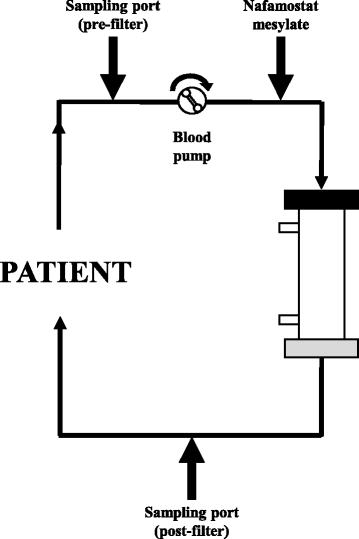AN69ST membranes adsorb nafamostat mesylate and affect the management of anticoagulant therapy: a retrospective study
- PMID: 28729905
- PMCID: PMC5516335
- DOI: 10.1186/s40560-017-0244-x
AN69ST membranes adsorb nafamostat mesylate and affect the management of anticoagulant therapy: a retrospective study
Abstract
Background: In Japan, nafamostat mesylate (NM) is frequently used as an anticoagulant during continuous renal replacement therapy (CRRT). The dialyzer membrane AN69ST has been reported to adsorb NM and affect the management of anticoagulant therapy. However, the adsorbed amount has not yet been quantitatively assessed. Therefore, in this study, we evaluated the pre- and post-hemofilter prolongation of the activated clotting time (ACT) in patients with AN69ST and PS membranes. We also measured the adsorption of NM in three types of CRRT membranes using an experimental model.
Methods: In a study of patients who underwent CRRT using AN69ST or PS membranes in 2015 at the Advanced Emergency and Critical Care Center, Okayama University Hospital, pre- and post-hemofilter ACT measurements were extracted retrospectively, and the difference was calculated. In addition, AN69ST (sepXiris100), PS (HEMOFEEL SHG-1.0), and PMMA membranes (HEMOFEEL CH-1.0N) were used in an in vitro model of a dialysis circuit, and the concentrations of NM were measured in pre- and post-hemofilter membranes and filtrates.
Results: The ACT difference was significantly lower in the group using AN69ST membranes (p < 0.01). In the in vitro model (n = 4) with adsorption and filtration, the post-hemofilter and filtrate concentrations of NM in AN69ST membranes were significantly lower than those in the PS and PMMA membranes (p < 0.01). The NM adsorption clearance of the AN69ST membrane was significantly higher than that of the PS and PMMA membranes.
Conclusions: The AN69ST membrane had higher NM adsorption than the PS and PMMA membranes. This may have resulted in the lower ACT difference in patients undergoing CRRT using the AN69ST membrane than in patients undergoing CRRT using PS or PMMA membranes.
Keywords: AN69ST; Adsorption; Anticoagulant therapy; Continuous renal replacement therapy; Nafamostat mesylate.
Conflict of interest statement
Ethical approval and consent to participate
This study was conducted in accordance with the principles of the Declaration of Helsinki because our research included a study that used human data. Our study was approved by the Ethics Committee of Okayama University Hospital (approval no. Ken1610-510). The study includes retrospective data with the highest privacy policy standards; therefore, the requirement of informed consent was waived.
Consent for publication
Not applicable.
Competing interests
The authors declare that they have no competing interests.
Publisher’s Note
Springer Nature remains neutral with regard to jurisdictional claims in published maps and institutional affiliations.
Figures





Similar articles
-
Evaluation of Proteins and Cells that Adsorb to Dialysis Membranes Used in Continuous Hemodiafiltration: Comparison of AN69ST, Polymethylmethacrylate, and Polysulfone Membranes.Blood Purif. 2019;48(4):358-367. doi: 10.1159/000501632. Epub 2019 Jul 25. Blood Purif. 2019. PMID: 31344702
-
Comparison of the cytokine adsorption ability in continuous renal replacement therapy using polyethyleneimine-coated polyacrylonitrile (AN69ST) or polymethylmethacrylate (PMMA) hemofilters: a pilot single-center open-label randomized control trial.Eur J Med Res. 2023 Jun 30;28(1):208. doi: 10.1186/s40001-023-01184-6. Eur J Med Res. 2023. PMID: 37391846 Free PMC article. Clinical Trial.
-
Adsorption of Nafamostat Mesilate on AN69ST Membranes: A Single-Center Retrospective and In Vitro Study.Ther Apher Dial. 2017 Dec;21(6):620-627. doi: 10.1111/1744-9987.12587. Epub 2017 Sep 28. Ther Apher Dial. 2017. PMID: 28960755
-
Effect of Continuous Renal Replacement Therapy with the oXiris Hemofilter on Critically Ill Patients: A Narrative Review.J Clin Med. 2022 Nov 13;11(22):6719. doi: 10.3390/jcm11226719. J Clin Med. 2022. PMID: 36431196 Free PMC article. Review.
-
Pharmacological interventions for preventing clotting of extracorporeal circuits during continuous renal replacement therapy.Cochrane Database Syst Rev. 2020 Dec 14;12(12):CD012467. doi: 10.1002/14651858.CD012467.pub3. Cochrane Database Syst Rev. 2020. PMID: 33314078 Free PMC article.
Cited by
-
Nafamostat Mesylate for Treatment of COVID-19 in Hospitalised Patients: A Structured, Narrative Review.Clin Pharmacokinet. 2022 Oct;61(10):1331-1343. doi: 10.1007/s40262-022-01170-x. Epub 2022 Aug 30. Clin Pharmacokinet. 2022. PMID: 36040613 Free PMC article. Review.
-
Efficacy and safety of nafamostat mesilate anticoagulation in blood purification treatment of critically ill patients: a systematic review and meta-analysis.Ren Fail. 2022 Dec;44(1):1263-1279. doi: 10.1080/0886022X.2022.2105233. Ren Fail. 2022. PMID: 35930302 Free PMC article.
-
How do filter types of renal replacement therapy affect survival in critically ill patients? Concerns about adsorption of nafamostat mesylate on AN69 membranes.BMC Nephrol. 2024 Sep 20;25(1):314. doi: 10.1186/s12882-024-03745-1. BMC Nephrol. 2024. PMID: 39304801 Free PMC article.
-
Comprehensive analysis of cytokine adsorption properties of polymethyl methacrylate (PMMA) membrane material.J Artif Organs. 2022 Dec;25(4):343-349. doi: 10.1007/s10047-022-01323-6. Epub 2022 Mar 17. J Artif Organs. 2022. PMID: 35301606 Free PMC article.
-
Additive effectiveness of acrylonitrile-co-methallyl sulfonate surface-treated membranes in the treatment of pneumonia: A propensity score-matched retrospective cohort study.Artif Organs. 2023 Feb;47(2):408-416. doi: 10.1111/aor.14435. Epub 2022 Nov 8. Artif Organs. 2023. PMID: 36310400 Free PMC article.
References
-
- Morabito S, Guzzo I, Solazzo A, Muzi L, Luciani R, Pierucci A. Continuous renal replacement therapies: anticoagulation in the critically ill at high risk of bleeding. J Nephrol. 2003;16:566–71. - PubMed
LinkOut - more resources
Full Text Sources
Other Literature Sources

